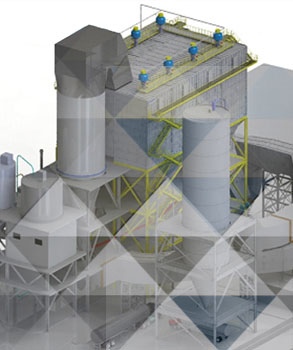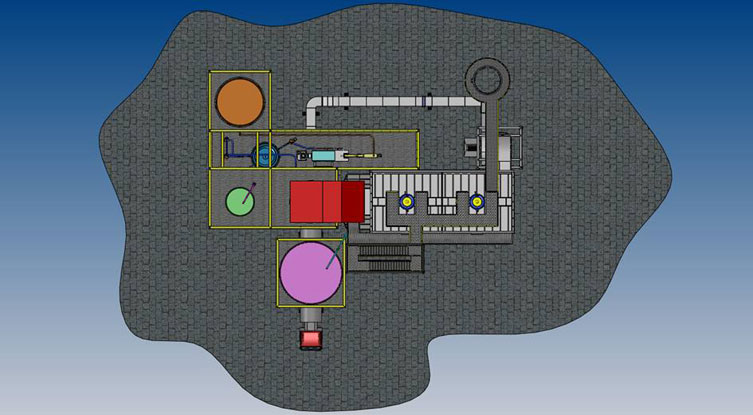Equipments
Dry System

The dry desulphurization process, according to the circulating fluidized bed (CFB) principle, operates at a temperature of approx. 75 - 85°C, normally using hydrated lime for the combined absorption of SO2, SO3, HF, and HCl. Such process produces a dry product, which is collected on the Cranfos Bai-Press 10™ bag filter, which is easily handled.
The absorber, located before the Bai-Press 10™ Bag Filter, is an empty vertical gas duct, with Venturi-type elements located at its base, which will enable the formation of the fluidized bed mixture with hydrated lime, recirculated desulphurization products, and combustion ashes.
Inside the circulating fluidized bed, solids are distributed along the entire height of the absorber. The average solid speed is much lower than the average gas speed, the speed difference is called “sliding speed”.
Such sliding speed between the flue gases and the solids is the fundamental criterion for heat and mass transfer inside the circulating fluidized bed absorber.
This will allow injecting water directly into the fluidized bed and controlling the absorbing temperature regardless of the amount of lime feed. The absorbing product, which mainly consists of calcium sulfite (CaSO3 x ½ H2O), calcium sulfate (CaSO4 x ½ H2O), limestone (CaCO3), and flue ashes, is separated from the cleaning gas downstream in the Cranfos Bai-Press 10™" Bag Filter.
The biggest part of the product collected in the Bag Filter is recirculated back to the absorber by means of fluidized chutes, which allows extending the retention time of sorbent solids. This enables the reduction of the Ca/S molar ratio in the process.
- Ca(OH)2 + SO2 ↔ CaSO3 • ½ H2O + ½ H2O
- Ca(OH)2 + SO3 ↔ CaSO4 • ½ H2O + ½ H2O
- CaSO3 • ½ H2O + ½ O2 ↔ CaSO4 • ½ H2O
- Ca(OH)2 + 2 HCl ↔ CaCl2 + 2 H2O
- Ca(OH)2 + 2 HF ↔ CaF2 + 2 H2O
- Ca(OH)2 + CO2 ↔ CaCO3 + H2O
CFB ABSORBER Advantages
On the CFB ABSORBER, water and hydrated lime injections are done separately, so that the Ca(OH)2 injection rate is solely controlled by the pollutant load at the equipment infeed, as well as the intended emission reduction, without being limited by the flue gas temperature or moisture content. As a result, the CFB ABSORBER can be operated for reducing emissions of a wide range of fuels, including sulfur-rich coals.
- Low investment and maintenance costs
- Simple, proven and reliable technology
- Absorbent dry infeed
- Besides the high SO2 removal, it is also possible to achieve an efficient HCl / HF removal
- Total SO3 removal
- Dry final product
- Absorption temperature over 20 to 30 C above the water dew point
- No clean gas reheating is required
- Low space requirements
- No need to pre-dedust
- Without water waste
- No special equipment inside the absorber
- No special material – only carbon steel
- No rubber coating on inner areas
- No need to apply corrosion protection
- High efficiency in absorbent use due to dust recirculation
- Different desulphurization efficiencies within the same plant
- Possibility of operating with reduced loads by installing the clean gas recirculating system, keeping the system flow always constant, even with the boiler operating at low load.
For more information, please refer to our Process Engineering crew.





